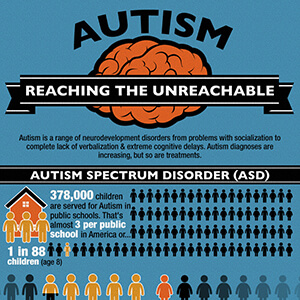
Autism: Reaching the Unreachable
Autism is a range of neurodevelopment disorders from problems with socialization to complete lack of verbalization and extreme cognitive delays. Autism diagnoses are increasing, but so are treatments. Lets take a look at reaching the unreachable.
Chances are you’ve run into someone with Autism Spectrum Disorder (ASD)
378,000 children are served for Autism in public schools[2]
That’s almost 3 per public school in America.[3]
Or, 1/88 children (age 8)[1]
It’s much more common in boys: 1 in 42 boys vs. 1 in 189 girls[5]
And it occurs in children of all racial, ethnic, and socioeconomic groups[5]
What Is ASD?
A number of previously separate and related disorders have been grouped together.
Here’s how DSM-5 outlines diagnosing ASD:
Generally less severe-
Asperger’s syndrome–
Often score average or above average on IQ tests.
Social problems
Limited scope of interests
Pervasive development disorder–
Children who have some autistic behaviors, but don’t fit into other categories.
Rett Syndrome–
Primarily amongst girls
Develop normally then lose communication and social skills
Repetitive hand movements instead of purposeful hand movements
Often severe cognitive impairment
Autistic Disorder–
Problems with social interactions, communication, and imaginative play
In children below 3.
Generally more severe++
Other characteristics:[7]
Repetitive behaviors
Communication Difficulties
Gastrointestinal Disorders
Seizure Disorders
Sleep Dysfunction
Sensory Processing Problems
Pica (the tendency to eat things that aren’t food)
What Causes It?
Genetic Factors:
If you have an identical twin with your exact genetic code
And they have ASD
9/10 times you will as well.
Environmental Factors:
Potential risk factors:
Family medical conditions
Parental age
Exposure to toxins
Complications during birth or pregnancy
But lets not worry about that…
…how can we help children with ASD?
Reaching the Unreachable
A child with ASD costs at least $17,000 more per year than a child without ASD
For:
Healthcare
Education
Autism-related therapy
Family-coordinated services
Caregiver time
Good thing special educators can help
1.) Identify ASD Early
Catch signs of developmental delays including:
Social
Emotional
and Cognitive milestones
Treatment for autism that starts in infancy takes full advantage of the plasticity of a child’s brain.
2.)For Aspergers Kids…
Organization is key
Use visual learning
Accept idiosyncrasies [#examples include not making eye contact, walking on their tiptoes, repetative movements.]
Don’t accept bullying
Limit sensory overload.
Connect projects with fixations
3.) For More Serious Autism…
Remember, behavior is communication
Look for sensory issues first
Find replacement behaviors for repetitive behavior
Create a quiet, relaxing “me” space
Use alternative communication technology
Citations:
- http://www.ninds.nih.gov/disorders/autism/detail_autism.htm
- https://nces.ed.gov/fastfacts/display.asp?id=64
- http://www.edreform.com/2012/04/k-12-facts/
- http://www.nimh.nih.gov/health/topics/autism-spectrum-disorders-pervasive-developmental-disorders/index.shtml?utm_source=rss_readersutm_medium=rssutm_campaign=rss_full
- http://www.oregonlive.com/health/index.ssf/2014/04/10_facts_about_autism_spectrum.html
- http://www.webmd.com/brain/autism/understanding-autism-basics
- http://www.autismspeaks.org/what-autism/symptoms
- http://www.myaspergerschild.com/2010/12/teaching-aspergers-students-32-tips-for.html
- http://www.helpguide.org/mental/autism_signs_symptoms.htm




